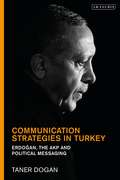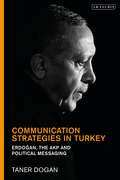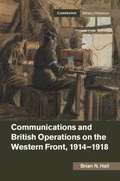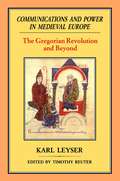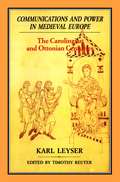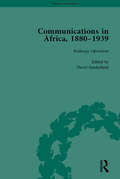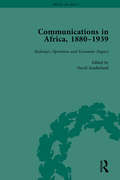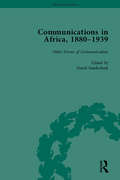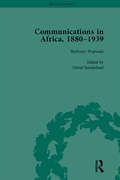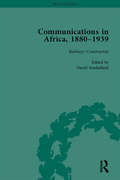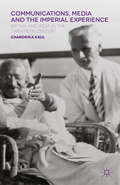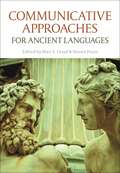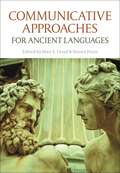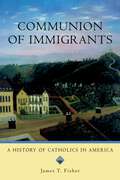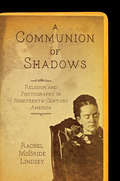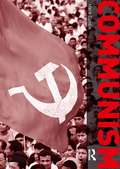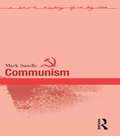- Table View
- List View
Communication Strategies in Turkey: Erdogan, the AKP and Political Messaging
by Taner DoganThe Turkish President Recep Tayyip Erdogan is known for his populist Islamist ideology, charismatic personality, and for ushering in new forms of communication strategies in Turkey. The key tools in Erdogan's political communication repertoire include religious, cultural and historic symbols and imagery. From engaging Israel to the Gezi Park protests, from the Arab uprisings to the July 2016 coup attempt, every key moment in Turkey's recent history has heralded a change in Erdogan's rhetoric.Communication Strategies in Turkey examines the transformation of political messaging that has taken place within the Justice and Development Party (AKP) under Erdogan. Using quantitative and qualitative analysis of in-depth interviews with high profile AKP officials, observations at AKP rallies and headquarters, and analysis of Erdogan's speeches from 2002 to 2019, the book shows how his method of communication changed over time to prioritise a “New Turkey” to replace Atatürk and his legacy.
Communication Strategies in Turkey: Erdogan, the AKP and Political Messaging
by Taner DoganThe Turkish President Recep Tayyip Erdogan is known for his populist Islamist ideology, charismatic personality, and for ushering in new forms of communication strategies in Turkey. The key tools in Erdogan's political communication repertoire include religious, cultural and historic symbols and imagery. From engaging Israel to the Gezi Park protests, from the Arab uprisings to the July 2016 coup attempt, every key moment in Turkey's recent history has heralded a change in Erdogan's rhetoric.Communication Strategies in Turkey examines the transformation of political messaging that has taken place within the Justice and Development Party (AKP) under Erdogan. Using quantitative and qualitative analysis of in-depth interviews with high profile AKP officials, observations at AKP rallies and headquarters, and analysis of Erdogan's speeches from 2002 to 2019, the book shows how his method of communication changed over time to prioritise a “New Turkey” to replace Atatürk and his legacy.
Communications and British Operations on the Western Front, 1914-1918 (Cambridge Military Histories Ser.)
by Brian N. HallThis is an important new study examining the military operations of the British Expeditionary Force in 1914–18 through the lens of its communications system. Brian Hall charts how new communications technology such as wireless, telephone and telegraph were used alongside visual signalling, carrier pigeons and runners as the British army struggled to develop a communication system adequate enough to wage modern warfare. He reveals how tenuous communications added to the difficulties of command and control during the war's early years, and examines their role during the major battles of the Somme, Arras, Ypres and Cambrai. It was only in 1918 that the British army would finally develop a flexible and sophisticated communications system capable of effectively coordinating infantry, artillery, tanks and aeroplanes. This is a major contribution to our understanding of British military operations during the First World War, the learning processes of armies and the revolution in military affairs.
Communications and Power in Medieval Europe: The Gregorian Revolution and Beyond
by Karl LeyserIn the first half of this collection of Karl Leyser's studies on the high middle ages, two themes are especially explored. The first is the European aristocratic world of the early eleventh century; the second is the fragmentation of this world in the course of the revolution set in motion by Gregory VII. The essays in the second half stress the importance of communications for the new forms of warfare and government developing in the twelfth century.
Communications and Power in Medieval Europe: The Carolingian and Ottonian Centuries
by Karl LeyserKarl Leyser's intuitive and imaginative historical writing drew on deep reading in the primary sources and, above all, on an intimate knowledge of the major historians of the period displayed in this collection of his work. It was his contention that only through an understanding of the minds of such historians as Nithard, Regino of Prum, Widukind of Corvey and Thietmar of Merseburg, and a reconstruction of their outlook on the world, can we appreciate the aristocratic worlds which these historians depicted in their works.
Communications in Africa, 1880 - 1939, Volume 3
by David SunderlandThis collection presents rare documents relating to the development of various forms of communication across Africa by the British, as part of their economic investment in Africa. Railways and waterways are examined.
Communications in Africa, 1880 - 1939, Volume 3: Railways: Operation And Economic Impact (Britain And Africa Ser.)
by David SunderlandThis collection presents rare documents relating to the development of various forms of communication across Africa by the British, as part of their economic investment in Africa. Railways and waterways are examined.
Communications in Africa, 1880 - 1939, Volume 4
by David SunderlandThis collection presents rare documents relating to the development of various forms of communication across Africa by the British, as part of their economic investment in Africa. Railways and waterways are examined.
Communications in Africa, 1880 - 1939, Volume 4
by David SunderlandThis collection presents rare documents relating to the development of various forms of communication across Africa by the British, as part of their economic investment in Africa. Railways and waterways are examined.
Communications in Africa, 1880 - 1939, Volume 5: Railways: Operation And Economic Impact (Britain And Africa Ser.)
by David SunderlandThis collection presents rare documents relating to the development of various forms of communication across Africa by the British, as part of their economic investment in Africa. Railways and waterways are examined.
Communications in Africa, 1880 - 1939, Volume 5
by David SunderlandThis collection presents rare documents relating to the development of various forms of communication across Africa by the British, as part of their economic investment in Africa. Railways and waterways are examined.
Communications in Africa, 1880–1939, Volume 1
by David SunderlandThis collection presents rare documents relating to the development of various forms of communication across Africa by the British, as part of their economic investment in Africa. Railways and waterways are examined.
Communications in Africa, 1880–1939, Volume 1: Railways: Operation And Economic Impact (Britain And Africa Ser.)
by David SunderlandThis collection presents rare documents relating to the development of various forms of communication across Africa by the British, as part of their economic investment in Africa. Railways and waterways are examined.
Communications in Africa, 1880–1939, Volume 2
by David SunderlandThis collection presents rare documents relating to the development of various forms of communication across Africa by the British, as part of their economic investment in Africa. Railways and waterways are examined.
Communications in Africa, 1880–1939, Volume 2: Railways: Operation And Economic Impact (Britain And Africa Ser.)
by David SunderlandThis collection presents rare documents relating to the development of various forms of communication across Africa by the British, as part of their economic investment in Africa. Railways and waterways are examined.
Communications, Media and the Imperial Experience: Britain and India in the Twentieth Century
by Chandrika KaulPresenting a communicational perspective on the British empire in India during the 20th century, the book seeks to examine how, and explain why, British proconsuls, civil servants and even the monarch George V, as well as Indian nationalists, interacted with the media, primarily British and American, and with what consequences.
Communicative Approaches for Ancient Languages
by Mair E. Lloyd and Steven HuntThis book is the first in its field. It showcases current and emerging communicative practices in the teaching and learning of ancient languages (Latin and Greek) across contemporary education in the US, the UK, South America and continental Europe. In all these parts of the globe, communicative approaches are increasingly being accepted as showing benefits for learners in school, university and college classrooms, as well as at specialist conferences which allow for total immersion in an ancient language. These approaches are characterised by interaction with others using the ancient language. They may include various means and modalities such as face-to-face conversations and written communication. The ultimate aim is to optimise the facility to read such languages with comprehension and engagement.The examples showcased in this volume provide readers with a vital survey of the most current issues in communicative language teaching, helping them to explore and consider adoption of a wider range of pedagogical practices, and encouraging them to develop tools to promote engagement and retention of a wider variety of students than currently find ancient languages accessible. Both new and experienced teachers and learners can build on the experiences and ideas in this volume to explore the value of these approaches in their own classrooms.
Communicative Approaches for Ancient Languages
This book is the first in its field. It showcases current and emerging communicative practices in the teaching and learning of ancient languages (Latin and Greek) across contemporary education in the US, the UK, South America and continental Europe. In all these parts of the globe, communicative approaches are increasingly being accepted as showing benefits for learners in school, university and college classrooms, as well as at specialist conferences which allow for total immersion in an ancient language. These approaches are characterised by interaction with others using the ancient language. They may include various means and modalities such as face-to-face conversations and written communication. The ultimate aim is to optimise the facility to read such languages with comprehension and engagement.The examples showcased in this volume provide readers with a vital survey of the most current issues in communicative language teaching, helping them to explore and consider adoption of a wider range of pedagogical practices, and encouraging them to develop tools to promote engagement and retention of a wider variety of students than currently find ancient languages accessible. Both new and experienced teachers and learners can build on the experiences and ideas in this volume to explore the value of these approaches in their own classrooms.
Communion of Immigrants: A History of Catholics in America (Religion in American Life)
by James T. FisherCatholicism has grown from a suppressed and persecuted outsiders' religion in the American colonies to become the nation's single largest denomination. James Fisher surveys more than four centuries of Catholics' involvement in American history, starting his narrative with one of the first Spanish expeditions to Florida, in 1528. He follows the transformation of Catholicism into one of America's most culturally and ethnically diverse religions, including the English Catholics' early settlement in Maryland, the Spanish missions to the Native Americans, the Irish and German poor who came in search of work and farmland, the proliferation of Polish and Italian communities, and the growing influx of Catholics from Latin America. The book discusses Catholic involvement in politics and conflict, from New York's Tammany Hall to the Vietnam War and abortion. Fisher highlights the critical role of women in American Catholicism--from St. Elizabeth Seton and Dorothy Day to Mother Cabrini, the first American citizen to be canonized a saint--and describes the influence of prominent American Catholics such as Cardinal John J. O'Connor, 1930s radio personality Father Charles Coughlin, President John F. Kennedy, pacifists Daniel and Philip Berrigan, activist Cesar Chavez, and author Flannery O'Connor. For this new edition, Fisher has brought the story up to date, including the latest struggles within the American church leadership.
Communion of Immigrants: A History of Catholics in America (Religion in American Life)
by James T. FisherCatholicism has grown from a suppressed and persecuted outsiders' religion in the American colonies to become the nation's single largest denomination. James Fisher surveys more than four centuries of Catholics' involvement in American history, starting his narrative with one of the first Spanish expeditions to Florida, in 1528. He follows the transformation of Catholicism into one of America's most culturally and ethnically diverse religions, including the English Catholics' early settlement in Maryland, the Spanish missions to the Native Americans, the Irish and German poor who came in search of work and farmland, the proliferation of Polish and Italian communities, and the growing influx of Catholics from Latin America. The book discusses Catholic involvement in politics and conflict, from New York's Tammany Hall to the Vietnam War and abortion. Fisher highlights the critical role of women in American Catholicism--from St. Elizabeth Seton and Dorothy Day to Mother Cabrini, the first American citizen to be canonized a saint--and describes the influence of prominent American Catholics such as Cardinal John J. O'Connor, 1930s radio personality Father Charles Coughlin, President John F. Kennedy, pacifists Daniel and Philip Berrigan, activist Cesar Chavez, and author Flannery O'Connor. For this new edition, Fisher has brought the story up to date, including the latest struggles within the American church leadership.
A Communion of Shadows: Religion and Photography in Nineteenth-Century America
by Rachel McBride LindseyWhen the revolutionary technology of photography erupted in American culture in 1839, it swiftly became, in the day's parlance, a "mania." This richly illustrated book positions vernacular photography at the center of the study of nineteenth-century American religious life. As an empirical tool, photography captured many of the signal scenes of American life, from the gold rush to the bloody battlefields of the Civil War. But photographs did not simply display neutral records of people, places, and things; rather, commonplace photographs became inscribed with spiritual meaning, disclosing, not merely signifying, a power that lay beyond.Rachel McBride Lindsey demonstrates that what people beheld when they looked at a photograph had as much to do with what lay outside the frame--theological expectations, for example--as with what the camera had recorded. Whether studio portraits tucked into Bibles, postmortem portraits with locks of hair attached, "spirit" photography, stereographs of the Holy Land, or magic lanterns used in biblical instruction, photographs were curated, beheld, displayed, and valued as physical artifacts that functioned both as relics and as icons of religious practice. Lindsey's interpretation of "vernacular" as an analytic introduces a way to consider anew the cultural, social, and material reach of religion.A multimedia collaboration with MAVCOR—Center for the Study of Material & Visual Cultures of Religion—at Yale University.
Communism
by Mark SandleWhy did communism grow so quickly? Why did it spread to turn almost half of the world red by the mid-1970s? What impact did it have upon capitalism and capitalist society?Communism is a concise introduction to one of the most important and influential movements of the 20th century. It shows how the modern communist movement emerged out of radical millenarian movements of the Middle Ages and the English Civil War, becoming a mass movement of industrial society, seeking to overturn capitalism and replace it with a society of equality, justice, harmony and co-operation. It traces the growth of modern communism from its beginnings in the early nineteenth century to its position of global power at the end of the Second World War. Mark Sandle investigates the ultimate failure of communism as a political ideology, and concludes by asking how far the historical record of communism has been used to conceal the historical record of capitalism.Ideal for courses in both History and Politics.
Communism
by Mark SandleWhy did communism grow so quickly? Why did it spread to turn almost half of the world red by the mid-1970s? What impact did it have upon capitalism and capitalist society?Communism is a concise introduction to one of the most important and influential movements of the 20th century. It shows how the modern communist movement emerged out of radical millenarian movements of the Middle Ages and the English Civil War, becoming a mass movement of industrial society, seeking to overturn capitalism and replace it with a society of equality, justice, harmony and co-operation. It traces the growth of modern communism from its beginnings in the early nineteenth century to its position of global power at the end of the Second World War. Mark Sandle investigates the ultimate failure of communism as a political ideology, and concludes by asking how far the historical record of communism has been used to conceal the historical record of capitalism.Ideal for courses in both History and Politics.
Communism
by Mark SandleThe twentieth century cannot be properly understood unless we understand communism: its origins, growth, demise and legacy. This brief overview of the history of communism challenges us to think about its role in shaping the contemporary world. This book shows how the modern communist movement emerged out of radical millenarian movements of the Middle Ages and the English Civil War, becoming a mass movement of industrial society, seeking to overturn capitalism and replace it with a society of equality, justice, harmony and co-operation. It traces the growth of modern communism from its beginnings in the early nineteenth century to its position of global power at the end of the Second World War. Why did communism grow so quickly? Why did it spread to turn almost half of the world red by the mid-1970s? What impact did it have upon capitalism and capitalist society?
Communism
by Mark SandleThe twentieth century cannot be properly understood unless we understand communism: its origins, growth, demise and legacy. This brief overview of the history of communism challenges us to think about its role in shaping the contemporary world. This book shows how the modern communist movement emerged out of radical millenarian movements of the Middle Ages and the English Civil War, becoming a mass movement of industrial society, seeking to overturn capitalism and replace it with a society of equality, justice, harmony and co-operation. It traces the growth of modern communism from its beginnings in the early nineteenth century to its position of global power at the end of the Second World War. Why did communism grow so quickly? Why did it spread to turn almost half of the world red by the mid-1970s? What impact did it have upon capitalism and capitalist society?
